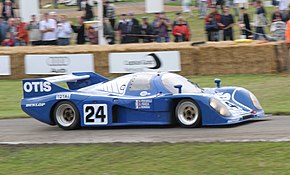Rondeau M382

The Rondeau M382 was a sports car prototype that was developed by Automobiles Jean Rondeau in 1981 and was used in sports car races from 1982 to 1986.
Development history and technology
The M382, developed under the leadership of the French racing driver and racing car designer, was the first Rondeau to comply with the Group C technical regulations that came into force in 1982 . Nevertheless, the M382 was largely based on the most successful Rondeau to date, the M379 model , with which Jean Rondeau and Jean-Pierre Jaussaud won the 1980 Le Mans 24-hour race . This was mainly due to financial reasons, as the small racing team from France always had to budget with the financial resources. The situation was made easier in the fall of 1981 when sales contracts were concluded for three chassis, which were delivered to three customer teams in early 1982.
In contrast to the M379, the M382 had a longer wheelbase, a new rear suspension, larger brakes at the front and rear, and an aerodynamically improved rear. Rondeau installed the 3.3-liter DFL V8 engine from Cosworth in the customer's car , which was also used on a number of works outings. In Le Mans, the works cars were converted to the more powerful 3.9-liter version of the DFL engine.
Racing history
At the beginning of 1982 four chassis had been completed. Two vehicles - chassis numbers 001 and 002 - were delivered to North America. Belcher Racing and Golden Eagle Racing field the cars in the IMSA GTP series . Chassis 003 was bought by the French racing driver and racing team owner Christian Bussi . Chassis 004 remained with Rondeau.
The M382 made its racing debut at the end of January 1982 at the Daytona 24-hour race . The two vehicles arrived in the USA just before the race, so the two teams had little time to prepare for the race and to set up the race. Both cars fell far short of expectations. The car reported by Golden Eagle Racing and driven by Bill Knoll , Irv Hoerr and Skeeter McKitterick only reached the 13th practice time; the Belcher Racing M382 , driven by Danny Sullivan , Gary Belcher and Hubert Phipps , was one place behind. With a pole position time of 1.43.891, both cars were more than nine seconds short of Bobby Rahal's fastest training time on a March 82G . During the race, both cars were repeatedly forced to pits on an unscheduled basis because of many technical inadequacies. Both vehicles were scored, but were no longer in the race at the end of the race.
Completely contrary to the race in Daytona, the racing debut of the M382 in Europe and the sports car world championship in 1982 was . At the 1000 km race in Monza , Henri Pescarolo qualified the works car on pole position and also won the race with team-mate Giorgio Francia .
While the racing successes in the IMSA-GTP series were virtually non-existent - it was not until July 1982 that Skeeter McKitterick was able to place an M382 in the top three with third place overall in the 100-mile race at Sears Point - the works car counted in the sports car category. World championship for the fastest and most successful vehicles in the field. After finishing second overall in the 1000 km race at the Nürburgring (behind the wheel Henri Pescarolo and Rolf Stommelen ), fifth place in the 6-hour race at Silverstone (Pescarolo and Gordon Spice ) and fifth overall in the 1000 km race of Spa-Francorchamps ( François Migault and Spice) Rondeau seemed certain of overall victory in the one-make cup of the World Sports Car Championship. The ninth place overall of the Porsche 930 registered as a Group B vehicle by Fritz Müller and Georg Memminger in the 1000 km race at the Nürburgring, however, brought Porsche an additional 15 points after a protest and thus overall victory in the World Championship of Manufacturers. A counter-prodigy by Jean Rondeau was unsuccessful, whereupon the completely angry Frenchman announced his factory retirement from the sports car world championship both as team boss and driver.
Only in the 24-hour race at Le Mans , where the works cars were canceled in 1982 and 1983 , did Rondeau continue to compete as a driver.
In 1983, in addition to the completely redesigned M482, three more chassis were built and delivered. The best placing of an M382 in the following years was the seventh place (chassis 005) of Pierre Yver and Bernard de Dryver in the 1000 km race of Monza in 1984 .
literature
- Thomas Nehlert, Group C: The sports car races 1982-1992 , Verlag Petrolpics, Bonn 2011, ISBN 3-940306-14-2 .